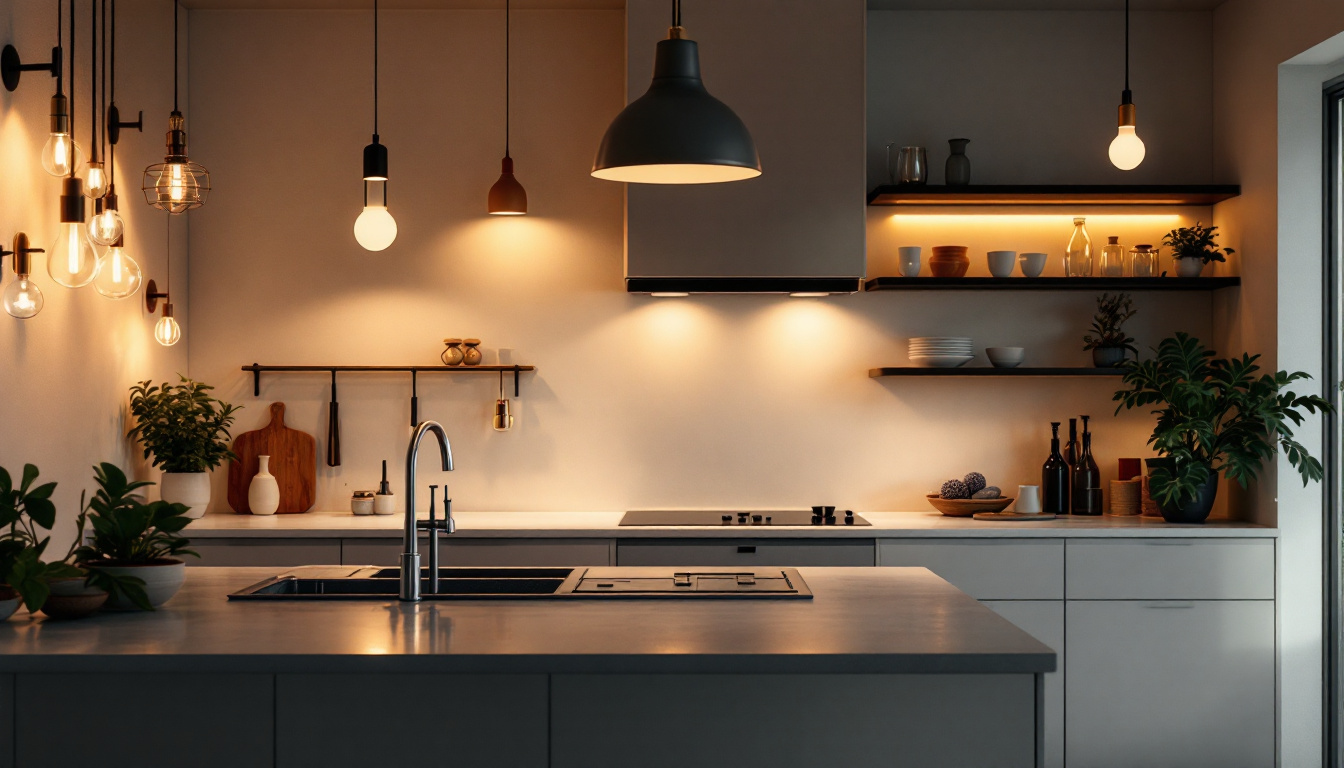
In the world of kitchen design, lighting plays a pivotal role in enhancing both functionality and aesthetics. For lighting contractors, understanding the nuances of kitchen island lighting is essential for delivering exceptional results. This guide explores the various aspects of kitchen island lighting, offering insights and practical tips to help contractors excel in their projects.
Kitchen islands serve as multifunctional spaces that often become the focal point of the kitchen. Proper lighting not only enhances the visual appeal but also improves usability. Whether for cooking, dining, or socializing, the right lighting can transform an ordinary kitchen into an extraordinary one.
One of the primary reasons for investing in quality lighting over a kitchen island is functionality. Adequate illumination ensures that tasks such as chopping, mixing, and plating are performed safely and efficiently. Poor lighting can lead to accidents, such as knife slips or spills, making it crucial to prioritize task lighting in these areas. Additionally, incorporating adjustable lighting options, such as dimmers or pendant lights with varying brightness settings, can provide the flexibility needed for different activities. For instance, bright lights may be ideal for meal prep, while softer lighting can create a warm ambiance for family gatherings or intimate dinners.
Beyond functionality, lighting contributes significantly to the overall aesthetic of the kitchen. The right fixtures can complement the design style, whether it be modern, rustic, or traditional. By selecting fixtures that align with the kitchen’s theme, contractors can create a cohesive look that enhances the homeowner’s experience. Moreover, the choice of materials and colors in lighting fixtures can reflect personal style and even set the mood for the entire space. For example, sleek metal fixtures can lend a contemporary edge, while vintage-inspired glass pendants can evoke a sense of nostalgia. Layering different types of lighting—such as ambient, task, and accent—can also add depth and character, allowing homeowners to highlight architectural features or decorative elements within the kitchen.
When it comes to kitchen island lighting, there are several types of lighting to consider. Each type serves a specific purpose and can be combined to achieve the desired effect.
Task lighting is essential for providing direct illumination over the kitchen island. Pendant lights are a popular choice for this purpose, as they can be hung at the right height to cast light directly onto the workspace. When selecting pendant lights, contractors should consider the size and scale of the island to ensure proper proportions. Additionally, the style of the pendant lights can greatly influence the overall aesthetic of the kitchen. For example, sleek, modern fixtures can complement contemporary designs, while vintage-inspired pendants can enhance a rustic or farmhouse feel. Dimming options can also be beneficial, allowing homeowners to adjust the brightness based on the time of day or the specific task at hand, whether it’s meal prep or entertaining guests.
Ambient lighting serves as the general illumination for the kitchen. It creates a warm and inviting atmosphere. Recessed lighting or ceiling-mounted fixtures can be used to provide ambient light throughout the kitchen, ensuring that the space feels open and welcoming. Furthermore, the color temperature of ambient lighting plays a significant role in setting the mood. Warmer tones can create a cozy environment, perfect for family gatherings, while cooler tones can make the space feel more energetic and vibrant. Layering ambient lighting with other types can also enhance functionality, ensuring that the kitchen is well-lit for both cooking and socializing.
Accent lighting is used to highlight specific features or areas within the kitchen. This could include under-cabinet lighting or decorative fixtures that draw attention to artwork or architectural elements. Incorporating accent lighting can add depth and character to the kitchen design. For instance, illuminating open shelving can showcase beautiful dishware or cookbooks, while highlighting a textured backsplash can create visual interest. Additionally, LED strip lights can be a versatile solution for accent lighting, providing a modern touch and allowing for creative placements that can transform the kitchen’s ambiance. The strategic use of accent lighting not only enhances the aesthetic appeal but also helps in creating focal points that guide the eye throughout the space.
Selecting the right fixtures is crucial for achieving the desired lighting effect in the kitchen. Several factors should be taken into account during the selection process.
The style of the fixtures should align with the overall kitchen design. For instance, a sleek, modern kitchen may benefit from minimalist pendant lights, while a farmhouse-style kitchen may call for more rustic, vintage-inspired fixtures. Contractors should work closely with clients to understand their preferences and vision. Additionally, incorporating unique designs, such as geometric shapes or artistic elements, can serve as a focal point in the kitchen, enhancing the aesthetic appeal while providing functional lighting.
When choosing fixtures, size and scale are critical considerations. A large kitchen island may require multiple pendant lights to provide adequate illumination, while a smaller island may only need one or two fixtures. It’s essential to maintain balance and proportion to avoid overwhelming the space. Moreover, the height at which fixtures are hung can dramatically affect the perception of space; for instance, lowering pendant lights over an island can create an intimate dining atmosphere, while higher placements can open up the area, making it feel more expansive.
The finish and material of the fixtures can also impact the overall look of the kitchen. Options range from polished chrome and brushed nickel to matte black and antique brass. Each finish can evoke a different mood, so contractors should consider how these elements will interact with other materials in the kitchen. Beyond aesthetics, the durability of materials is also a significant factor; for example, choosing fixtures made from corrosion-resistant materials is essential in kitchens where humidity levels may fluctuate. Furthermore, mixing and matching finishes can add depth and character, allowing homeowners to express their personal style while maintaining a cohesive look throughout the space.
Proper installation is key to achieving the best results in kitchen island lighting. Here are some essential tips for lighting contractors to keep in mind.
The height at which pendant lights are hung is crucial for both aesthetics and functionality. A general rule of thumb is to hang pendant lights 30 to 36 inches above the countertop. This height allows for adequate illumination while ensuring that the fixtures do not obstruct views or interfere with movement around the island.
Before installation, it’s important to assess the existing wiring and electrical setup. Contractors should ensure that the electrical system can support the new fixtures and that all wiring is up to code. Additionally, incorporating dimmer switches can provide flexibility in adjusting the lighting levels based on the time of day or activity.
Layering different types of lighting—task, ambient, and accent—can create a well-balanced and functional kitchen environment. Contractors should plan the layout carefully to ensure that all areas of the kitchen island are adequately illuminated. This approach not only enhances usability but also adds depth and interest to the space.
Staying updated on the latest trends in kitchen island lighting can help contractors offer innovative solutions to their clients. Here are some current trends that are shaping the industry.
Smart lighting technology is becoming increasingly popular in modern kitchens. Homeowners are looking for ways to integrate technology into their spaces, and smart lighting allows for remote control and automation. Contractors should familiarize themselves with smart lighting systems and be prepared to offer these options to clients.
Another trend gaining traction is the use of mixed materials in lighting fixtures. Combining metals, glass, and wood can create unique and eye-catching designs. This approach allows for greater customization and can help contractors cater to a variety of design preferences.
Industrial and vintage lighting styles continue to be popular choices for kitchen islands. These styles often feature exposed bulbs, metal finishes, and unique shapes that add character to the space. Contractors should consider offering a range of fixtures that align with these trends to appeal to a broader audience.
Even experienced contractors can make mistakes when it comes to kitchen island lighting. Being aware of common pitfalls can help ensure successful installations.
One of the most common mistakes is overlooking the scale of the fixtures in relation to the kitchen island. Choosing fixtures that are too small can result in inadequate lighting, while oversized fixtures can overwhelm the space. It’s essential to maintain a balance that complements the island’s size.
Another mistake is neglecting to incorporate layered lighting. Relying solely on task lighting can create harsh shadows and an uninviting atmosphere. By combining different types of lighting, contractors can create a more dynamic and functional space.
Finally, ignoring client preferences can lead to dissatisfaction with the final result. It’s crucial for contractors to engage in open communication with clients throughout the design and installation process. Understanding their vision and preferences will lead to a more successful outcome.
Kitchen island lighting is a vital aspect of kitchen design that requires careful consideration and expertise. By understanding the importance of lighting, selecting the right fixtures, and following best practices for installation, lighting contractors can create stunning and functional spaces that meet the needs of their clients.
Staying informed about trends and avoiding common mistakes will further enhance a contractor’s ability to deliver exceptional results. With the right approach, kitchen island lighting can elevate a kitchen’s design, making it a welcoming and efficient space for homeowners.
Ready to take your kitchen island lighting projects to the next level? At LumenWholesale, we provide lighting contractors with the highest quality, spec-grade lighting products at prices that can’t be beaten. Our extensive selection is designed to meet the most rigorous industry standards, ensuring your installations shine with reliability and performance. Say goodbye to middleman markups and hello to hassle-free bulk buying with free shipping. Elevate your lighting game and give your clients the best value in lighting solutions. Discover wholesale lighting at the best value today and make every kitchen island project a masterpiece with LumenWholesale.

Explore the essential components of light fixtures with our simplified guide tailored for lighting contractors.

Discover innovative cost-saving strategies for lighting contractors with LED lights for can lights.

Discover how Keystone LED lights are transforming the landscape for lighting contractors.

Discover innovative hacks for smart lighting contractors to enhance outdoor spaces with solar-powered sconces.